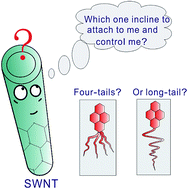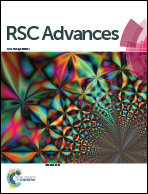Functionalization of single-walled carbon nanotubes with thermo-responsive poly(N-isopropylacrylamide): effect of the polymer architecture†
Abstract
The functionalization of single-walled carbon nanotubes (SWNTs) using non-covalently interacting stimuli-responsive polymers in aqueous media has opened up a new area of study for SWNTs in biology and medicine. We prepared thermo-responsive pyrene-labelled four-arm star-shaped poly(N-isopropylacrylamide) (p-SPNIPAM) and linear p-PNIPAM by atom transfer radical polymerization and then used these two polymers to modify SWNTs. The two polymers could be attached onto the sidewall of nanotubes by π–π stacking between the pyrene group and the SWNTs, but p-SPNIPAM imparted a better solubility to the SWNTs than p-PNIPAM. In addition, when the temperature of the dispersion was above the cloudy point of the polymer solution, the p-SPNIPAM/SWNT hybrids formed compact large diameter bundles, whereas the p-PNIPAM/SWNTs formed small loose bundles floating in water. The aggregated SWNTs hybrids were re-dispersed below the cloudy point. Thus SWNT hybrids are not only dispersed in water, but also undergo reversible dispersion and aggregation by tuning temperature, making them attractive in biomedical or sensory applications. The architecture of the thermo-sensitive polymers also affects the dispersibility of SWNTS and their “smart” behaviour.


 Please wait while we load your content...
Please wait while we load your content...